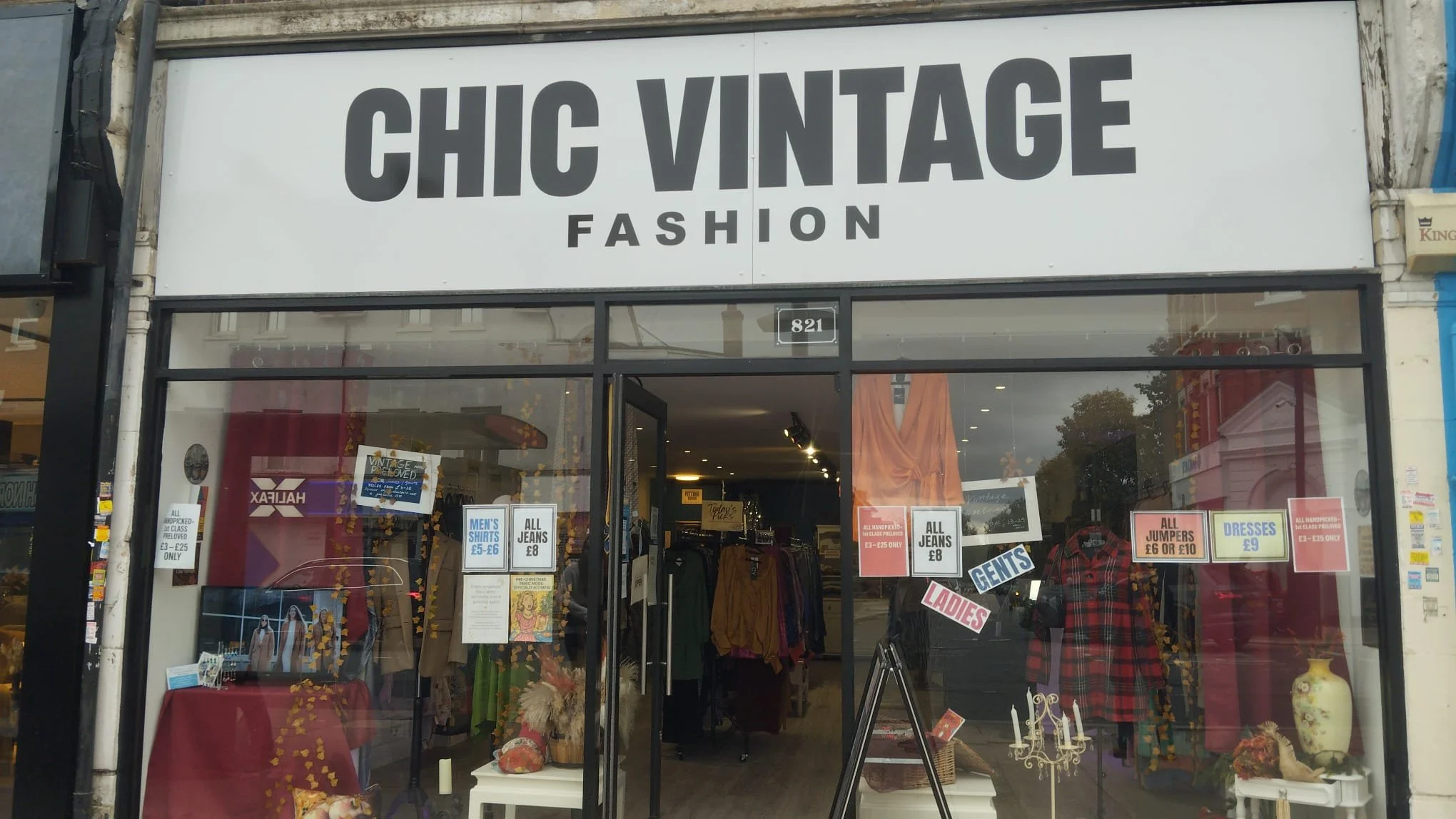Textile circularity: How to find the clothes you want second-hand
Photo by Prudence Earl on Unsplash
8th October 2025 is World Circular Textiles Day. Textile circularity aims to minimise clothing waste, improve garment longevity and improve the textile recycling process.
Not only does theses changes need to be backed by development of new technologies, but also a shift in approach to textile design and consumer beliefs and behaviours.
As the Textile Exchange conclude, the point of this is to “minimize waste and pollution, keep products and materials in use, and regenerate natural systems.”
Buying second-hand is part of this approach. Charity shops, online platforms and thrift or vintage stores play a key role in reducing textile waste. Buying second-hand helps keep millions of tons of textiles out of landfill or being dumped in the global south. And, in theory it reduces the need for production of new garments.
Why do we need textile circularity?
Fast fashion refers to cheaply produced clothes, sold at an extremely low price point. Garments designed to be on trend, worn a few times and then disposed of. This destructive production model relies on super-fast, low-cost manufacturing. Pushed out into the market at break-neck speed.
We cannot deny that the fast fashion industry is having a huge impact on the planet. Using vast amounts of water and adding to greenhouse gas emissions: partially caused by burning fossil fuels for industry.
Companies like Shein are the most obvious culprits. But this production model also applies to a large proportion of the fashion industry, including popular brands like Zara, H&M and ASOS, as well as supermarket clothing lines.
Even Marks & Spencer, the ex-stalwart of the British high street, now makes it onto lists of fast fashion companies . Accused of greenwashing and operating using a “linear, fast fashion model for its own-brand clothing labels.”
What is the impact of textile and clothing production?
The fashion industry in general contributes to climate change and pollution.
From the immense use of water (93 billion cubic meters per year), at a time when there is a rising struggle to access fresh water across the planet. As well as contributions to water pollution and microplastic waste. To ·textile production’s substantial contribution to fossil fuel emission and synthetic fabrics creating plastic pollution. To exploitative and dangerous textile production processes and abysmal labour rights. Not forgetting the most direct threats to life, such as the 2013 Rana Plaza factory collapse which killed 1134 Bangladeshi workers.
But what can I do about fast fashion?
The above facts and stats are only scratching the surface of the environmental and human cost of fast fashion.
Yet, all this information can feel overwhelming. It can be easy to turn away from when it seems like there is nothing to be done to make a difference.
But there are simple things you can do today to help break the cycle of this destructive and throwaway approach to consuming fashion and move towards greater circularity.
As individuals this is one tangible thing we can do to contribute to textile circularity and as an action to prevent further climate damage. Shop pre-loved!
According to a report from Vinted, buying second-hand through their platform avoided 678,691 tonnes of CO₂e emissions in 2023. And did you know that enough clothing already exists in the world to clothe the next 6 generations of the human race. Basically any clothing you need is already out there!
A vintage shop in Finchley, North London
Shifts in consumer behaviour
The good news is that in general, shopping habits have already begun to change. According to Trustpilot, sales of second-hand goods, including clothing, increased by 15% in 2022 which equates to £21 billion. Suez’s report found that 48% of UK adults bought a second-hand item in the last year
Buying pre-loved items is new territory for a lot of people. There are still fears, worries and stigma around buying clothes that have already been worn.
I have been shopping second-hand since I was a child, spurred on by my mum who was on a budget, but loved clothes. Now as a 43-year-old all of the clothes I buy are pre-loved, as are nearly all of my kid’s clothes!
So, here’s some tried and tested suggestions to help you join this growing second-hand shopping community:
How to find the preloved clothes you need
Maybe you want something specific, or you are shopping for an occasion? Follow these quick tips to make the hunt easier:
· Get even more specific
Do a quick audit of your existing clothes. Take a moment to see if you have something in your wardrobe that would already do the trick. If there is a gap, going armed with a list, or at least a broad idea of what you want, can help you hone in and save time.
Is there a specific brand you know that you like? This is helpful if you’re doing preloved shopping online. It can also be helpful to think of fabrics and materials. You may be thinking of natural fabrics like cotton, wool or silk. Or perhaps you don’t mind some synthetic materials or more of a Lycra-based stretch in your clothing!
· Use an online second-hand marketplace
Of course you’ve heard of Vinted, Ebay, Depop, Thrift+ and other second-hand online market places. Using these platforms you can filter by size, colour, condition and others, to focus your searches. So, it’s pretty much like any other sort of online shopping!
Go to specific websites or shops if you only want high-end, luxury or designer pieces. Vestaire Collective is one popular example. There are also lots of sellers via Instagram who curate specific second-hand collections if you want that more bespoke boutique experience! Just do a bit of a search using keywords like preloved, second-hand, vintage, and so on, depending on what you are looking for.
You can be even faster by using a screenshot or photo of what you want, and then using Google Lens search. Add the keywords Ebay UK, Vinted or other online retailers to the search and you will quickly be taken to lots of specific second-hand options. Again you can narrow it done with you clothes size or other specifics.
It’s also possible to search these market-places for brand new pieces that have never been worn or hardly worn. Probably as a testament to our attitude to buying more than we need: there are lots on there! For example, Vinted has an option to filter by condition and you can choose ‘new with tags.’
How to use filters on Vinted
· Charity shops and thrift shops have upped their game
If you haven’t been in a charity shop or vintage shop for a while, you could be imagining a jumble of dirty clothes. But nowadays, this is not the case. Most second-hand or vintage shops are well organised, and clothes are often steamed and smell nice!
It’s generally easy to browse and/or find a particular item you may be searching for. It sounds obvious but most second-hand shops organize items into men's, women's, and children's clothes and accessories. As well as by size or often colour. Sometimes, they have a vintage or designer rail as well.
Again, you could target your search to only preloved shops that only sell designer clothes. Looking in charity shops in upmarket areas is a good way to go about this. For example, near me in North London I can go to upper middle class Muswell Hill or bougie Marylebone High Street to look for some swish outfits! Be prepared to pay more though.
Men’s jackets in Oxfam
· It’s not just about thrifting
Have you ever been to a swap-shop or clothes swapping event? If you are doing a clear out, see if you could swap with a friend, or look out for a local clothes swap. Or you could even start one yourself in your workplace or local community. Hubbub have some advice on running a clothes swap.
· You don’t have to aim for a fully-thrifted wardrobe, start small
The bottom line is that even small changes help. Start somewhere that feels comfortable for you.
Going for timeless, classic and well-made pieces you can treasure, is a good approach.
More in depth information on textile circularity and a vision for the future: World Textile Circularity 2050
I’m Anneliese, a writer with a love of all things scientific, research-focused, technical or sustainable. Aiming to make content as clear, engaging and (sometimes) fun as possible!
Let me know if you have any other questions about textile circularity and second-hand shopping, or what other articles you’d like to see in this area: anneliese@thoughtfulcontent.co.uk




